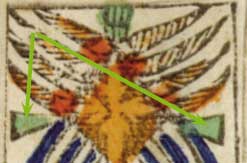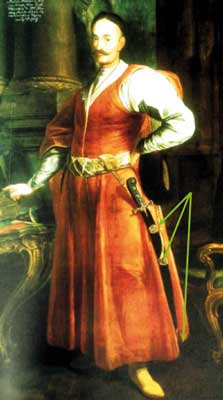jmd
Let's resume our comparisons of Dodal and Conver, beginning with also taking-in the Vieville:
 <-- Vieville/Dodal | Conver -->
<-- Vieville/Dodal | Conver -->

Perhaps the only other currently existing 'Contrast' thread on swords (Three Swords) could also here be looked at.
One of the points that arises with the suit of swords is whether the straight sword(s) are upright when pointing up or down. Here I shall make a few other comments on this by also bringing in a couple of sevens (simply because the point to be made will be more easily seen, and access to images is otherwise rather limited).
But let's first look at the above cards.
In all three cases shown above, we have two straight swords crossed in the centre of eight curved swords (henceforth called scimitars).
The Scimitars are shown 'bound' by a number of factors, including a common hilt depiction, and the mid-sections having a band that crosses over all swords:

This is not the case in all early decks that are reminiscent of the Marseille pattern.
What is apparent in all the above images is that the Marseille-pattern has standardised the scimitars to virtual point of no recognition with regards to what is hilt and what is blade-tip (I realise that I have before made that point). If anything, this aspect is, from my perspective, a loss in both the Payen-Dodal and the Conver (the two principal 'standards' for the Marseille-pattern) - more on that a little later.
What is also of interest are those two 'flowers' on the three cards above.
If one looks at them carefully, there is a progression from ambiguity as to what this in fact is (Vieville), to increased clarity to floral depiction (Conver). Perhaps it was not flower originally intended, but rather a pattern remnant that the artist needed to make sense of with loss of earlier model that accounts for the design... let me show what I mean.
In Vitali and Zanetti's book Il Tarocchino di Bologna (in Italian, even for those who do not read Italian, the images are worth having the book), is a late (18th century) Bolognese deck, reproducing what are clearly earlier images. I would suggest that some of these harken back to pre-standardised Marseille. Let's have a look at that ten of swords (and the seven, as clarity for the point will be more easily seen):
 <-- 10 Epees | 7 Epees -->
<-- 10 Epees | 7 Epees -->

It perhaps should be noted that the nine of swords is in all details the same as the ten, except that it does not have that horizontal (blue) blade running through the middle.
I would suggest that it is that horizontal partial sword that is problematic, and that resulted in an altered depiction of two smaller straight swords presented crossed, as in the Marseille pattern shown by the Vieville, Dodal and Conver above.
But now observe what would happen if the central sword was removed, but the artist or woodcarver had 'accidentally' copied the tips of the hilt-guard. After all, it is not totally obvious that this belongs to the un-connected sword when copying:

I suggest that these remnants from a few of these cards (including the seven and nine) may have lead to floral additions possibly originally absent.
Note can be taken that the Bolognese deck above already has the swords 'bound' by common hilt (that here is nonetheless distinct from blade tip), by red-'ties' mid-blade, and by that pattern over the criss-crossing: here, I suspect the Marseille has maintained the simple criss-crossing of an earlier type, such as presented in Kaplan's Encyclopedia of Tarot vol II, p288 (I show the seven swords, as the ten is not shown):

Effectively, is appears as a 'cleaner' rendition of both the Marseille and the Bologna. Kaplan mentions that this deck is possibly from 16th century Ferrara or Venice (I would be more inclined to the former), now located the Museo delle Arti in Rome.
Again, we have the scimitars with clear visually distinct hilt and blade-tip. Also, we have the 'simpler' scimitar blade criss-crossing... but importantly, here we have the blades not apparently 'bound' (though the hilts are still shared by all swords).
I would add, based on this model, another possible observation: the single (Christian) sword is unsheathed point down (to hint at the Cross), and the scimitars are in their scabards. I suggest this for two reasons: the first is that though blades may have thereon carvings, the central sections and the blade tips clearly reflect what the scimitar would look like in scabbard rather than sheathed; the second is that as the blades of the scimitars point upwards relative the single sword, its sheathing marks them as not in battle - both single sword and scimitar are then not in combat mode (on this, I stand to be corrected as to my relatively poor knowledge).
The only image easily accessible I had of a sheathed scimitar, showing those mid-sections and blade tip re-enforced scabbard is the following:

...I think this thread is already so much longer than intended - in part, I wanted to include reflections as to why I also mention in the three of swords thread why I have, over the past few years, altered my view that considers the upright sense of the Sword suit as single straight sword point down, and why I have for quite some time considered that the Marseille unclarity of hilt-sword-tip a loss of detail.


Perhaps the only other currently existing 'Contrast' thread on swords (Three Swords) could also here be looked at.
One of the points that arises with the suit of swords is whether the straight sword(s) are upright when pointing up or down. Here I shall make a few other comments on this by also bringing in a couple of sevens (simply because the point to be made will be more easily seen, and access to images is otherwise rather limited).
But let's first look at the above cards.
In all three cases shown above, we have two straight swords crossed in the centre of eight curved swords (henceforth called scimitars).
The Scimitars are shown 'bound' by a number of factors, including a common hilt depiction, and the mid-sections having a band that crosses over all swords:

This is not the case in all early decks that are reminiscent of the Marseille pattern.
What is apparent in all the above images is that the Marseille-pattern has standardised the scimitars to virtual point of no recognition with regards to what is hilt and what is blade-tip (I realise that I have before made that point). If anything, this aspect is, from my perspective, a loss in both the Payen-Dodal and the Conver (the two principal 'standards' for the Marseille-pattern) - more on that a little later.
What is also of interest are those two 'flowers' on the three cards above.
If one looks at them carefully, there is a progression from ambiguity as to what this in fact is (Vieville), to increased clarity to floral depiction (Conver). Perhaps it was not flower originally intended, but rather a pattern remnant that the artist needed to make sense of with loss of earlier model that accounts for the design... let me show what I mean.
In Vitali and Zanetti's book Il Tarocchino di Bologna (in Italian, even for those who do not read Italian, the images are worth having the book), is a late (18th century) Bolognese deck, reproducing what are clearly earlier images. I would suggest that some of these harken back to pre-standardised Marseille. Let's have a look at that ten of swords (and the seven, as clarity for the point will be more easily seen):


It perhaps should be noted that the nine of swords is in all details the same as the ten, except that it does not have that horizontal (blue) blade running through the middle.
I would suggest that it is that horizontal partial sword that is problematic, and that resulted in an altered depiction of two smaller straight swords presented crossed, as in the Marseille pattern shown by the Vieville, Dodal and Conver above.
But now observe what would happen if the central sword was removed, but the artist or woodcarver had 'accidentally' copied the tips of the hilt-guard. After all, it is not totally obvious that this belongs to the un-connected sword when copying:

I suggest that these remnants from a few of these cards (including the seven and nine) may have lead to floral additions possibly originally absent.
Note can be taken that the Bolognese deck above already has the swords 'bound' by common hilt (that here is nonetheless distinct from blade tip), by red-'ties' mid-blade, and by that pattern over the criss-crossing: here, I suspect the Marseille has maintained the simple criss-crossing of an earlier type, such as presented in Kaplan's Encyclopedia of Tarot vol II, p288 (I show the seven swords, as the ten is not shown):

Effectively, is appears as a 'cleaner' rendition of both the Marseille and the Bologna. Kaplan mentions that this deck is possibly from 16th century Ferrara or Venice (I would be more inclined to the former), now located the Museo delle Arti in Rome.
Again, we have the scimitars with clear visually distinct hilt and blade-tip. Also, we have the 'simpler' scimitar blade criss-crossing... but importantly, here we have the blades not apparently 'bound' (though the hilts are still shared by all swords).
I would add, based on this model, another possible observation: the single (Christian) sword is unsheathed point down (to hint at the Cross), and the scimitars are in their scabards. I suggest this for two reasons: the first is that though blades may have thereon carvings, the central sections and the blade tips clearly reflect what the scimitar would look like in scabbard rather than sheathed; the second is that as the blades of the scimitars point upwards relative the single sword, its sheathing marks them as not in battle - both single sword and scimitar are then not in combat mode (on this, I stand to be corrected as to my relatively poor knowledge).
The only image easily accessible I had of a sheathed scimitar, showing those mid-sections and blade tip re-enforced scabbard is the following:

...I think this thread is already so much longer than intended - in part, I wanted to include reflections as to why I also mention in the three of swords thread why I have, over the past few years, altered my view that considers the upright sense of the Sword suit as single straight sword point down, and why I have for quite some time considered that the Marseille unclarity of hilt-sword-tip a loss of detail.

